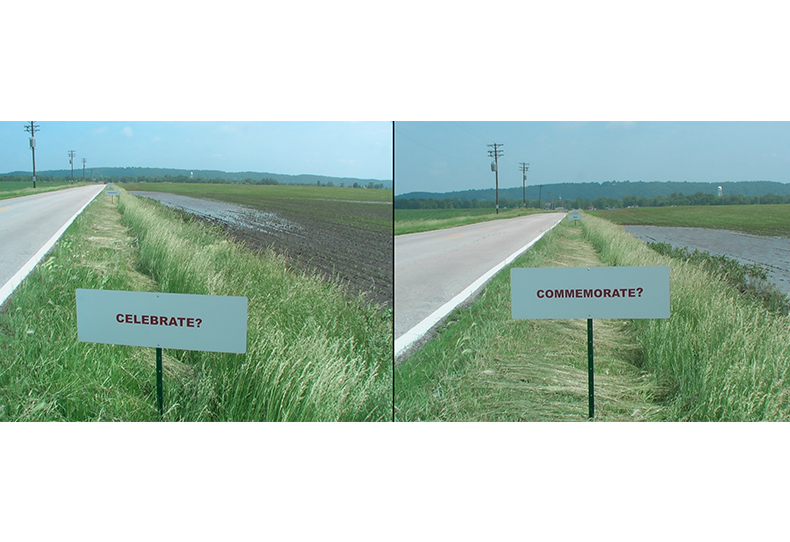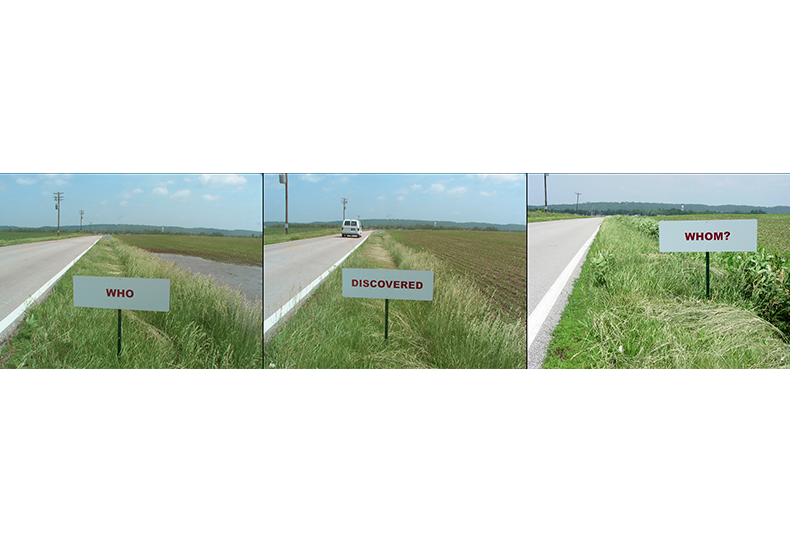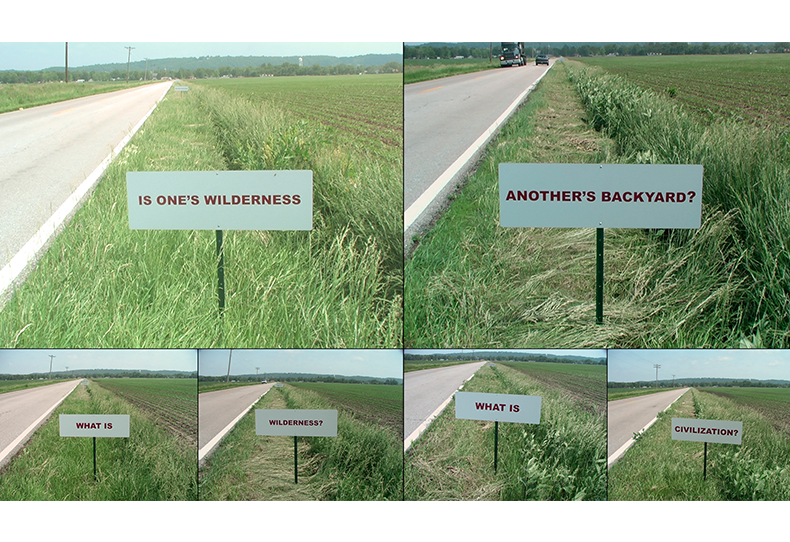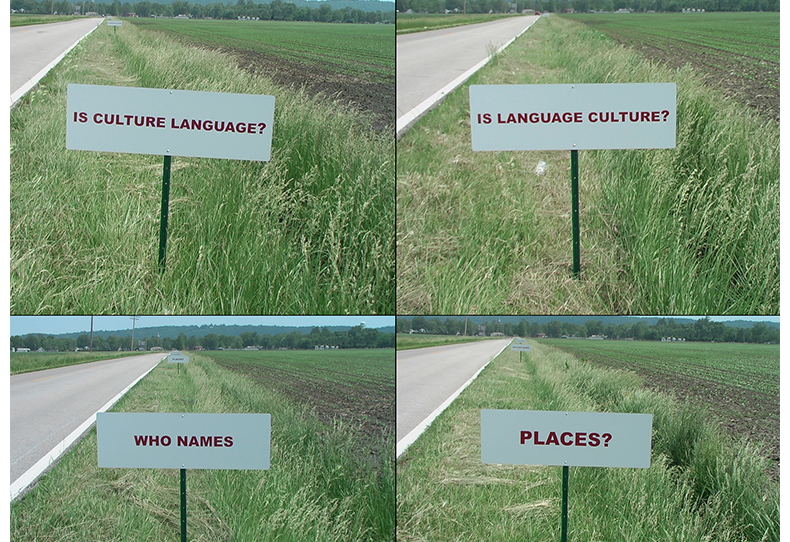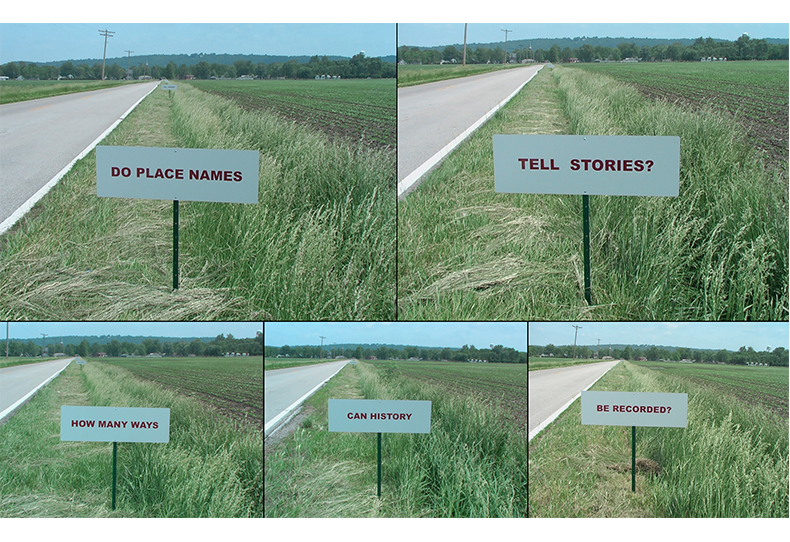Who Discovered Whom?
with Matthew Dehaemers, Portage des Sioux, Missouri, 2004, 25 enameled steel signs, each 15 x 35" containing 12 questions, route J into town, 1 mile long.
Complete text of signs:
Celebrate? Commemorate? Who Discovered Whom? Is one's wilderness another's backyard? What is Wilderness? What is Civilization? Is culture language? Is language culture? Who names Places? Do place names tell stories? How many ways can history be recorded? Oral traditions? Written traditions? Is everything you read true?
The text says it all, and it could have only happened after all our research and experiences visiting and learning from many American Indian friends and teachers. After we first drove the one mile road "J" into Portage des Sioux, Matt had brought up the possibility of using the format of the old "Burma Shave" roadside ads as a possibility for our project. We both liked this idea because Route "J" is almost the only way in or out of town, but what to say? That was the crucial issue. Then I heard two board members of the National Council of Lewis and Clark Bicentennial speak at the Tent of Many Voices, Allen Pinkham, Chairperson and a founding member of the Circle of Tribal Advisors, and Bobbie Conner, Director of the Tamastslikt Cultural Institute in Pendleton, Oregon. They had organized their presentations around language; Allen began with some key words and concepts as he talked about how encounters educate, and how redefining and clarifying words can support that. He zeroed in on the words celebration and commemoration, especially in the context of discussion among those first planning for the national Lewis and Clark Bicentennial. He also brought up the notion of discovery, what that means and to whom, he said "who discovered whom?" (There's a great essay I read, by James Ronda, entitled "Exploring the Explorers", that also shed light on this, as well as my readings in Colin Calloway's, One Vast Winter Count). Allen Pinkham spoke of identifying perspectivesand about what is civilized and what is civilization. His discussion on wilderness included his saying that "we were part of the animal people....and still are today". Bobbie read from the old Northwest Ordinance and spoke of how the Lewis and Clark story "is a story about land". She mentioned that American "Indian names for places were stories", names that L&C disregarded as they renamed places within the Louisiana Purchase territory. She went on to talk about the "Corps of Discovery" as living precariously where they didn't belong, in a land where the Indians could identify 30 kinds of useful roots, many berries and so on. She said "we fell off the map" and the Circle of Tribal Advisors is trying to put us back on it. She encouraged us to join with them in taking care of the land, communicating, recognizing Indian contributions to culture - from philosophy and religion to law - and in taking care of creatures with wings, on the land and in the water.
After hearing them speak I wrote the first draft of the signs. Matt liked the text and so we met with Bobbie Conner and Amy Mossett (Tribal Involvement Coordinator, National Council of the Lewis and Clark Bicentennial). Bobbie encouraged us to use humor in our work and we tried to do that in a gentle way, "IS ONES WILDERNESS, ANOTHERS BACKYARD?" came from Bobbie. With a little reworking and with their input, we made the signs for "WHO DISCOVERED WHOM".
Special thanks to Mark Warner, Mayor of Portage des Sioux, Debrah Lappe, Signature Event Coordinator, Allen Pinkham, Bobbie Connor, Amy Mossett, John White Antelope, Director, American Indian Center, St. Louis, Lewis and Clark Community College, Godfrey, Illiinois, Jim Price, organizer, Crossing Borders Symposium.
